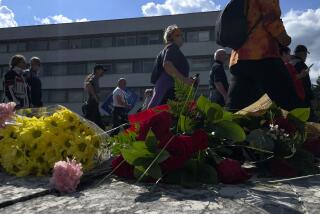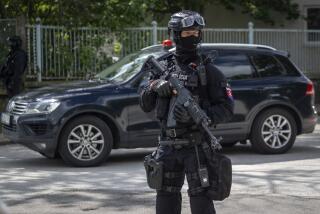Swedish Leader Olof Palme, 59, Assassinated
- Share via
STOCKHOLM — Swedish Prime Minister Olof Palme was shot on a city street and died at a hospital Friday night, Finance Minister Kjell-Olof Feldt said Saturday.
Police issued an alert for a dark-haired man aged 35 to 40 and dressed in a long, dark overcoat, according to the Swedish domestic news agency, TT. It also said police pursued a Volkswagen headed out of the capital city that was believed to be carrying a suspect.
Palme, 59, apparently was shot with a handgun on a street corner in central Stockholm, the news agency said. It quoted witnesses as saying he was hit twice in the stomach. The agency said Palme died at approximately 11:30 p.m. (2:30 p.m. PST) Friday at Sabbatsbergs Hospital, where he had been taken by an emergency vehicle.
A taxi driver found Palme lying on a snow-covered sidewalk at a corner of a central crossing. The driver alerted police through a switchboard, and a police bus was dispatched to the site, according to a police statement quoted by TT. As was customary in Sweden, he had no bodyguard.
Police cordoned off several blocks in the center of the city.
Deputy Prime Minister Ingvar Carlsson arrived at 1 a.m. today at the Government House to head a crisis meeting with other Cabinet members.
“We have asked all those we could get to come over here. It is horrible. I just got to know it 30 minutes ago,” Carlsson told the TT agency.
The agency said that, according to a preliminary police report, there were at least four witnesses to the shooting, including two young girls who tried to help him.
One report from the news agency said Palme’s wife, Lisbeth, was with him at the time of the shooting and arrived at the hospital in an ambulance. Police said Mrs. Palme suffered a slight back injury.
Palme was last reelected to a three-year term in September, 1985.
He entered the Swedish Parliament in 1956 and served in a variety of Cabinet posts. He was prime minister the first time from 1969 to 1976, when his defeat ended 44 years of Socialist rule in Sweden.
He was an outspoken critic of U.S. involvement in the Vietnam War, and in 1968 took part in an anti-war demonstration in Stockholm with the North Vietnamese ambassador to Sweden. The act led to a call for his resignation from Parliament.
He once likened former President Richard M. Nixon’s 1972 order for the bombing of Hanoi to acts committed by Adolf Hitler.
Palme was known for his participation in international politics. A supporter of the Third World in its battles with industrialized nations, Palme once aspired to become the next secretary general of the United Nations.
In May, 1980, Palme joined Austrian Chancellor Bruno Kreisky and Spanish Socialist leader Felipe Gonzalez--now his nation’s prime minister--in a three-man Socialist International mission to Tehran to seek a solution to the U.S.-Iran crisis.
Palme was a member of the Brandt Commission, which studied ways of narrowing the gap between rich and poor nations.
He was born Jan. 30, 1927, into a Baltic noble family but was proud of his involvement with the working class.
“I was born into the upper class, but I belong to the labor movement,” he once said. “I got there by working for the working class on its own terms, by joining the movement working for freedom, equality and fraternity among people.”
Palme, who spoke fluent English, German and French and some Russian, was educated at Ohio’s Kenyon College and at the University of Stockholm.
He won a scholarship to Kenyon College in Gambier, Ohio, where in 1948 he racked up straight A’s and earned a bachelor’s degree in just one year. He hitchhiked through 34 states for four months on $300.
He later recalled he “saw how poor some people were in the world’s richest land.”
A year later, he married a Czechoslovakian student in Prague simply to help her leave her Communist country for the West. They left for Sweden immediately after their December, 1949, wedding and later divorced as planned.
Palme is survived by his wife, Lisbeth, a child psychologist whom he married in 1956, and three grown sons.
More to Read
Sign up for Essential California
The most important California stories and recommendations in your inbox every morning.
You may occasionally receive promotional content from the Los Angeles Times.










